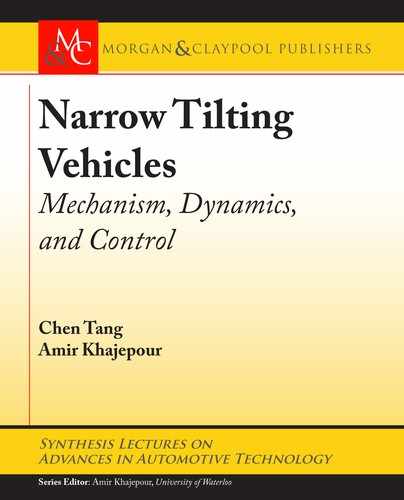4.6. INTEGRATED FEEDBACK CONTROL: SMC DESIGN EXAMPLE 47
4.6.3 SIMULATION RESULTS
SMC Case A: Re-Configurable Integrated Vehicle Control
is scenario is designed to demonstrate the re-configurable feature of the integrated control
approach. A ramp steering of 0.06 rad is applied to the front axle when the vehicle travels at
60 km/h. Four different actuator configurations are considered:
• Baseline – Four wheel torque vectoring, no roll control:
R
Case1
D diag
0 0 0 0 0 0 1 0 1 1 0 1 0
I
• AT + AFS – Active front steering C active tilting:
R
Case2
D diag
1 0 1 0 0 0 0 0 0 0 0 0 1
I
• AT C TV Four wheel torque vectoring C active tilting:
R
Case3
D diag
0 0 0 0 0 0 1 0 1 1 0 1 1
I
• AT C AFS C TV Active front steering C four wheel torque vectoring C tilting:
R
Case4
D diag
1 0 1 0 0 0 1 0 1 1 0 1 1
:
Since the roll dynamics is very dependent on the lateral acceleration disturbances, the ve-
hicle with torque vectoring (Case 1) for yaw rate tracking is chosen as the baseline for a fair
comparison. e active steering is applied to both front wheels, and a roll envelope bound-
ary with LTR
lim
D 0:5 is adopted for the demonstration. Results in Figure 4.8 show that the
proposed envelope controller with different actuation systems successfully mitigate the rollover
danger by reducing LTR index from 0:7 to 0:5.
Although similar roll and lateral stability performances can be achieved with different
actuators using the proposed integrated control scheme, the control efforts are different. Case 3
(ATCTV) requires most tilting torques, as the desired yaw rate is tracked by torque vectoring,
and most of the desired roll moment is generated by tilting actuators.
Case 2 (ATCAFS) adopts active steering actuators. As shown in the control effectiveness
matrix, apart from the yaw motion tracking, lateral tire forces generated by active steering could
directly help the rollover mitigation. A compromise can then be made to balance two control
targets. In this simulation, the weight is tuned to give a priority to the rollover mitigation [70].
e handling performance evaluated by the yaw rate tracking is decreased. Consequently, the
control effort exerted by the tilting mechanism also gets reduced.
When all actuators are available as shown in Case 4 (ATCAFSCTV), the vehicle per-
formances can be further improved. e desired yaw rate can be better tracked by utilizing both
torque vectoring and active steering when roll envelope control is not activated, and control
efforts could be minimized between actuators. However, when the roll mitigation control is re-
quired, the active steering could be tuned to help reducing the active tilting moment, while the
vehicle handling performance is not compromised. e desired yaw rate, as shown in the figure,
could still be maintained by the torque vectoring thanks to the integrated formulation.

48 4. TILTING VEHICLE CONTROL
δ
d
(deg)r (rad/s)φ (deg)
LTRa
y
(m/s
)T
x
(N.m)
4
2
0
δ
cfr
(deg)
0
-0.2
-0.4
5
2
-5
0
-0.2
-0.4
-0.6
-0.8
0.4
0.3
0.2
0.1
0
0 2 4 6 0 2 4 6
0 2 4 6 0 2 4 6
6
4
2
0
1
0
-1
-2
∆Q
cfr
(N.m)
150
100
50
0
0 2 4 6 0 2 4 6
0 2 4 6 0 2 4 6
× 10
4
Base
Time (s) Time (s)
AT+AFS AT+AFS+TVAT+TV
Figure 4.8: Various actuator configurations with the roll envelope-based control.
..................Content has been hidden....................
You can't read the all page of ebook, please click here login for view all page.
